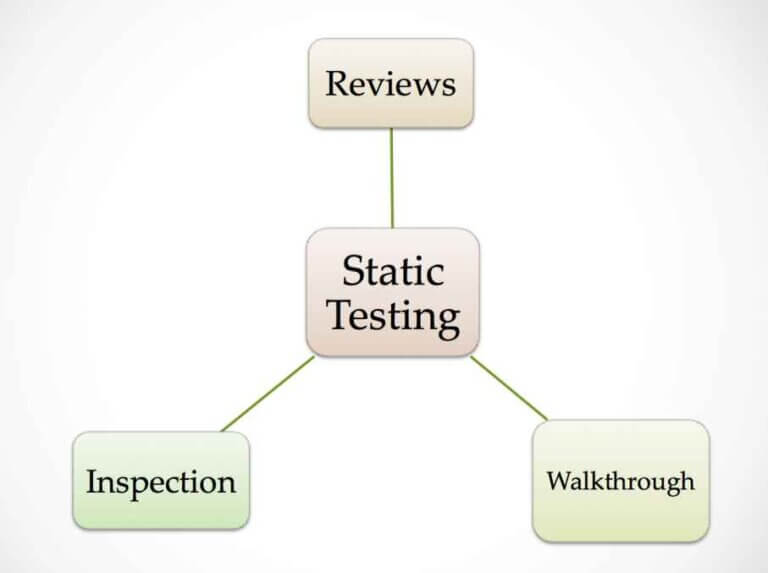Testing Foundation
Basics of Software Testing
What is Software Testing?
Objective of Testing
Why is testing necessary?
Common Terms used in Testing
Verification Vs Validations
QA Vs QC
Debugging Vs Testing
Seven Testing Principles
SDLC Vs STLC
Fundamentals of Test Process
Software quality Factors
Software Development Models
Waterfall Model
V models
Iterative Model
Test Levels
Component Testing
Integration Testing
System Testing
Acceptance Testing
Strategies for Integration Testing
Big Bang
Stubs and Driver
Top Down Testing
Bottom Up Testing
Test Types
Functional Testing
Non- Functional Testing
Structural Testing
Re-testing & Regression Testing
Static AND Dynamic Techniques
Static Technique
Dynamic Technique
Static Analysis by Tools
White Box Techniques
Statement Coverage Testing
Branch Coverage Testing
Decision Coverage Testing
Path Coverage
Black Box Techniques
Equivalence Partitioning
Boundary Value Analysis
Decision Table testing
State Transition testing
Experience Based TestingTechniques
Random Testing
Exploratory Testing
Error Guessing
Functional Testing
Integration Testing
Unit Testing
System Testing
Smoke testing
Sanity testing
Regression Testing
Usability Testing
Security Testing
User Acceptance Testing
White Box & Black Box Testing
Globalization & Localization Testing
Non Functional Testing
Compatibility testing
Endurance testing
Load testing
Performance testing
Recovery testing
Scalability testing
Stress testing
Volume testing
Test Planning and Estimation
Test Planning
Test Strategies Vs Test Plan
Test Approaches
Risk and Testing
Product Risks
Project Risks
Defect Management
Defect LifeCycle
Severity Vs Priority
What is Software Testing?
Objective of Testing
Why is testing necessary?
Common Terms used in Testing
Verification Vs Validations
QA Vs QC
Debugging Vs Testing
Seven Testing Principles
SDLC Vs STLC
Fundamentals of Test Process
Software quality Factors
Software Development Models
Waterfall Model
V models
Iterative Model
Test Levels
Component Testing
Integration Testing
System Testing
Acceptance Testing
Strategies for Integration Testing
Big Bang
Stubs and Driver
Top Down Testing
Bottom Up Testing
Test Types
Functional Testing
Non- Functional Testing
Structural Testing
Re-testing & Regression Testing
Static AND Dynamic Techniques
Static Technique
Dynamic Technique
Static Analysis by Tools
White Box Techniques
Statement Coverage Testing
Branch Coverage Testing
Decision Coverage Testing
Path Coverage
Black Box Techniques
Equivalence Partitioning
Boundary Value Analysis
Decision Table testing
State Transition testing
Experience Based TestingTechniques
Random Testing
Exploratory Testing
Error Guessing
Functional Testing
Integration Testing
Unit Testing
System Testing
Smoke testing
Sanity testing
Regression Testing
Usability Testing
Security Testing
User Acceptance Testing
White Box & Black Box Testing
Globalization & Localization Testing
Non Functional Testing
Compatibility testing
Endurance testing
Load testing
Performance testing
Recovery testing
Scalability testing
Stress testing
Volume testing
Test Planning and Estimation
Test Planning
Test Strategies Vs Test Plan
Test Approaches
Risk and Testing
Product Risks
Project Risks
Defect Management
Defect LifeCycle
Severity Vs Priority
Static Testing | Definition ,Techniques and Types
- Static testing is defined as “Verification of software code or other project documentation without executing the code.”
- Verification can be done manual or with the help of tool.
- This technique help in identifying defects earlier in the development cycle.
- Static Technique checks the code, requirement and design documents and puts review comments on these documents.
- This Technique helps in finding the errors, code flaws and malicious code in the software application.
- Static testing starts in the earlier phase of development cycle so it is also called verification testing.

What can be verified using Static Testing Techniques?
- Test Plans
- Test Designs
- Code
- Test Data
- Test Cases
- Reports, etc.
Types of Static testing techniques:

Reviews:
-
-
- A process or meeting during which a work product or a set of work products, is presented to project personnel, managers, users, customers or other interested parties for comment or approval.
- Documents are reviewed formally or informally and comments are provided.
- Design documents, Code, Test plan, Test Specification, Test Cases etc. can be reviewed.
- A review characterised by documented procedures is called Formal Review
- A review not based documented procedure called Informal review
-
Inspection:
-
-
- Inspection is the most Formal review type so checklist is prepared to review the work documents.
- Main objective is to find defect
- Trained moderator conducts Walkthroughs
- During inspection the documents are prepared and checked thoroughly by the reviewers before the meeting
- It involves peers to examine the product
- Inspection meeting has proper entry and exit criteria.
- Defects found in the meeting are documented in the issue log or logging list.
- Reports created during the meeting are shared with the Author to take appropriate actions on that.
- A formal follow-up is carried out by the moderator applying exit criteria
-
Walkthrough:
-
-
- Author leads the review process to fulfil the common understanding and other team members ask the possible questions and submit their feedback collected
- Meeting is lead by author to explain the product. Participants can ask questions and a scribe is assigned to make notes.
- To explain and evaluate the contents of the document
- Main objective is to establish a common understanding of the document
- The Scribe notes minutes of Meeting and the defects or any findings reported down in order to track them later.
-
Desk checking:
-
-
- Informal review process where that author or Programmer can use to verify coding and algorithm logic before a launching the code.
- Author/Programmer runs through lines of code to identify errors and to check logic.
- Author/Programmer will print out the code and go through it in a pencil and paper exercise
- Desk checking is quick and inexpensive.
- We can call it as one-person inspection or walkthrough:
-
Recommended Articles:
Testing Foundation
Basics of Software Testing
What is Software Testing?
Objective of Testing
Why is testing necessary?
Common Terms used in Testing
Verification Vs Validations
QA Vs QC
Debugging Vs Testing
Seven Testing Principles
SDLC Vs STLC
Fundamentals of Test Process
Software quality Factors
Software Development Models
Waterfall Model
V models
Iterative Model
Test Levels
Component Testing
Integration Testing
System Testing
Acceptance Testing
Strategies for Integration Testing
Big Bang
Stubs and Driver
Top Down Testing
Bottom Up Testing
Test Types
Functional Testing
Non- Functional Testing
Structural Testing
Re-testing & Regression Testing
Static AND Dynamic Techniques
Static Technique
Dynamic Technique
Static Analysis by Tools
White Box Techniques
Statement Coverage Testing
Branch Coverage Testing
Decision Coverage Testing
Path Coverage
Black Box Techniques
Equivalence Partitioning
Boundary Value Analysis
Decision Table testing
State Transition testing
Experience Based TestingTechniques
Random Testing
Exploratory Testing
Error Guessing
Functional Testing
Integration Testing
Unit Testing
System Testing
Smoke testing
Sanity testing
Regression Testing
Usability Testing
Security Testing
User Acceptance Testing
White Box & Black Box Testing
Globalization & Localization Testing
Non Functional Testing
Compatibility testing
Endurance testing
Load testing
Performance testing
Recovery testing
Scalability testing
Stress testing
Volume testing
Test Planning and Estimation
Test Planning
Test Strategies Vs Test Plan
Test Approaches
Risk and Testing
Product Risks
Project Risks
Defect Management
Defect LifeCycle
Severity Vs Priority
What is Software Testing?
Objective of Testing
Why is testing necessary?
Common Terms used in Testing
Verification Vs Validations
QA Vs QC
Debugging Vs Testing
Seven Testing Principles
SDLC Vs STLC
Fundamentals of Test Process
Software quality Factors
Software Development Models
Waterfall Model
V models
Iterative Model
Test Levels
Component Testing
Integration Testing
System Testing
Acceptance Testing
Strategies for Integration Testing
Big Bang
Stubs and Driver
Top Down Testing
Bottom Up Testing
Test Types
Functional Testing
Non- Functional Testing
Structural Testing
Re-testing & Regression Testing
Static AND Dynamic Techniques
Static Technique
Dynamic Technique
Static Analysis by Tools
White Box Techniques
Statement Coverage Testing
Branch Coverage Testing
Decision Coverage Testing
Path Coverage
Black Box Techniques
Equivalence Partitioning
Boundary Value Analysis
Decision Table testing
State Transition testing
Experience Based TestingTechniques
Random Testing
Exploratory Testing
Error Guessing
Functional Testing
Integration Testing
Unit Testing
System Testing
Smoke testing
Sanity testing
Regression Testing
Usability Testing
Security Testing
User Acceptance Testing
White Box & Black Box Testing
Globalization & Localization Testing
Non Functional Testing
Compatibility testing
Endurance testing
Load testing
Performance testing
Recovery testing
Scalability testing
Stress testing
Volume testing
Test Planning and Estimation
Test Planning
Test Strategies Vs Test Plan
Test Approaches
Risk and Testing
Product Risks
Project Risks
Defect Management
Defect LifeCycle
Severity Vs Priority
